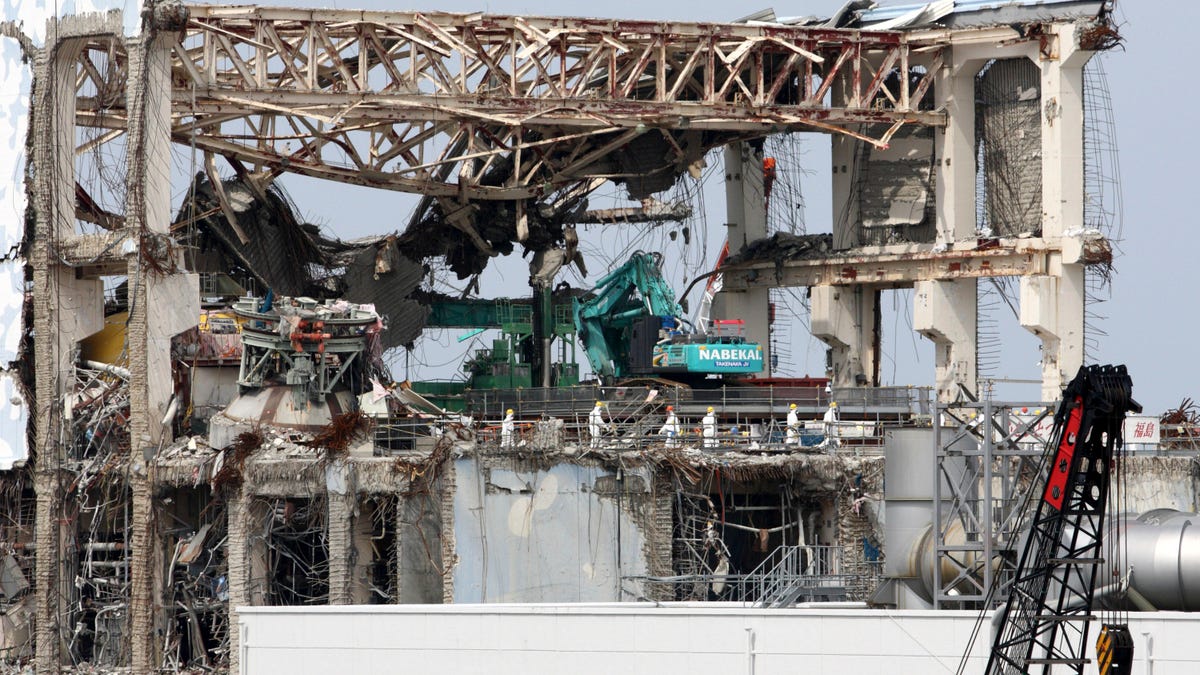
May 26, 2012: Goshi Hosono, Japan's environment and nuclear minister, third from left, wearing a red helmet, along with members of the media, walks on the No. 4 reactor building at Tokyo Electric Power Co.'s (TEPCO) Fukushima Dai-ichi nuclear power plant in Okuma, Fukushima prefecture, Japan. (AP2012)
TOKYO – Japan's environment and nuclear minister visited the tsunami-crippled Fukushima Dai-ichi nuclear power plant on Saturday to inspect a spent fuel pool at the center of safety concerns and said it appeared to have been properly reinforced.
The visit by Goshi Hosono, apparently aimed at demonstrating the safety of the facility, came amid renewed concerns about conditions at the plant's No. 4 reactor after its operator reported a bulging of the building's wall. Nuclear regulators ordered a new investigation and seismic tests of the building and its pool.
The building was damaged by an explosion and fire soon after the Fukushima plant was hit by a massive magnitude-9.0 earthquake and tsunami on March 11, 2011. The pool, located at the top of the building above the reactor, remains one of the plant's biggest risks due to its vulnerability to earthquakes.
The plant's operator, Tokyo Electric Power Co., has reinforced the structure and says it now can withstand temblors as strong as last year's quake.
A small group of journalists was allowed to enter the reactor building for the first time with Hosono. Inside there were piles of broken wall panels, pieces of cement and mangled equipment, showing the magnitude of the explosion.
Hosono, wearing protective coveralls and a full-face mask, climbed a narrow scaffolding to the fifth floor to see the pool, which was covered with a protective tarp. TEPCO officials lifted part of the cover to show the water surface.
Hosono later told reporters that he could see that the pool had been sufficiently reinforced.
"I could see steady progress being made toward removal of the spent fuel (from the pool), which is the next major goal," he said.
The fuel rods in storage pools are not enclosed as they are in reactor cores and could cause a greater release of radiation in case of a loss of water.
Ikko Nakatsuka, a vice minister of reconstruction who saw the No. 4 reactor during a plant tour in April, said earlier this week that the building and its pool are more vulnerable than the other reactors and uncertainties remain.
TEPCO is preparing to move the fuel rods from the pool to a joint pool for all six reactors next to the building, but the process won't start until late next year. The joint pool is located on the ground level and is considered safer, even though it already has 6,000 fuel rods in it, officials said. It is expected to take 10 years before the removal of melted fuel from three damaged reactors can start.
Akio Komori, one of TEPCO executives who escorted Hosono, said the company will inspect the Reactor 4 building to reevaluate its safety to ensure its integrity while continuing with the fuel removal.
From early on, experts have raised concerns about the pool at the No. 4 reactor, where 1,535 fuel rods -- the most of any of Fukushima's six reactors -- were stored because the reactor was undergoing major refurbishing and the fuel ordinarily inside its core was also stored in the pool.
A worst-case scenario envisioned by the head of the Japan Atomic Energy Commission two weeks after last year's accident warned that a melting of the fuel rods at Unit 4 would require the evacuation of 30 million people just from the greater Tokyo area.
